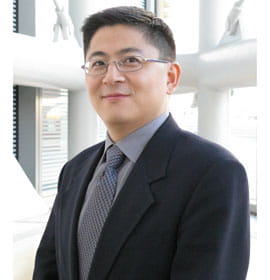Engineers Develop Shish Kebab Shaped Buckypaper

- On the Trail of Deepfakes, Drexel Researchers Identify ‘Fingerprints’ of AI-Generated Video
- New AI-Technology Estimates Brain Age Using Low-Cost EEG Device
- Bolstered by Research Consortium with Drexel, Jefferson’s Sidney Kimmel Cancer Center Earns NCI Comprehensive Cancer Center Designation
- Alyssa Kemp Named as 2024 Truman Scholar

Next-generation body armor and batteries could be within reach according to a group of Drexel University engineers who recently presented their work with a sophisticated weave of carbon nanotubes, commonly called buckypaper, in ACS Nano, a publication of the American Chemical Society.
The researchers, led by Dr. Christopher Li, a professor in Drexel’s Materials Science and Engineering Department, reported the process to fabricate a new form of buckypaper using a nano hybrid structure resembling a shish kebab. In the shish kebab the “skewers” are nanotubes and polymer crystal are the “kebabs” that hold the nanotubes apart. Li demonstrated that the crystals allow researchers to control the pores’ sizes and change the buckypaper’s conductivities, surface roughness and abilities to shed water.
Materials Ph.D. students Eric Laird, Wenda Wang, Shan Cheng, Bing Li, who are all advised by Li, Ph.D. student Boris Dyatkin, who is advised by Dr. Yury Gogotsi, Dr. Volker Presser, Gogotsi and Li are the co-authors on "Polymer Single Crystal-Decorated Superhydrophobic Buckypaper with Controlled Wetting and Conductivity." The research, funded by the National Science Foundation, reports that there are several ways to make buckypaper, which conducts heat and electricity better than most known materials.
“This research shows that we can use this ‘shish-kebab’ instead of the carbon nanotube itself to build a three-dimensional membrane with controlled pore size, so this opens up a playground for using it for electrochemical devices such as batteries,” Li said.
Standard buckypaper is formed by depositing a very thin layer of entangled carbon nanotubes to create a fiber mat akin to office paper. Li and colleagues note that no existing post-processing method allows researchers to increase the size of the tiny holes, or pores, between the carbon nanotubes after they form the buckypaper. Li’s group looked for a way to do that and to introduce other substances to buckypaper that could make it more useful in electronics or as sensors.
In This Article
Contact
Drexel News is produced by
University Marketing and Communications.